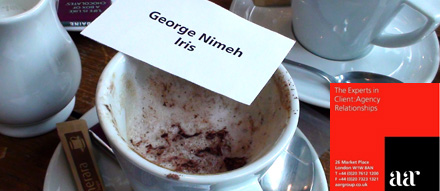NLP with the AARAnother nice turnout at this morning's Digital Breakfast series
organized by the AAR here in London.
After a much-needed dose of caffeine, we settled into breakfast room at
Aubaine to spend some time with
Dawn Sillett, who gave us a primer on
neuro-linguistic programming (NLP) and some insight in terms of how to apply NLP to the agency biz.
Essentially, NLP helps people to understand “preferred representational systems”. In plain English, I’d say that means how people make sense of the world and other people around them. There are three main preferred representational systems, audio, visual and kinaesthetic. Knowing which type you are (and what type others are) can provide very powerful insight into relationship building both inside and outside the office.
Building rapport when we’re dealing with clients and prospects should be something that comes naturally, right? Not necessarily...yet with some simple techniques we can all raise our game. Neuro Linguistic Programming (NLP) is often applied in professional sport, coaching, business and especially sales. What you will get from this interactive breakfast briefing is a no-nonsense insight into how you can use simple NLP techniques to make more effective use of chemistry meetings, presentations and pitches. You will explore your own preferences and how these can influence your rapport-building, and take away 5 practical tips to apply right away.Here are Dawn’s 5 Tips to use your senses to build better relationships mixed with vox-pops from other people who attended the breakfast.
1) Look at your last presentation. Ask yourself if you are catering to all three preferred representational systems or heavily weighted to one or the other.
2) Identify colleagues with different preferences and combine them wisely internally and for external client and new business work.
3) Revamp your new business kit. Is it hitting all three rep systems? Got a podcast? And so on ...
4) Turn up the auditory. For most, this is the weakest of the three. Don’t forget it.
5) Feel the love. Don’t forget about ergonomics. How people feel when you’re presenting can be as important as what they’re looking at. Seating, lighting, and other physical attributes should be taken into consideration. And don’t forget what people touch during meetings as well as what they take with them.
As for me, I wonder how this all combines in terms of the work we do in the digital space. Can we use the same three categories to be better at creating a more comprehensive user experience? Is there a relevant and otherwise valuable way to group what we do according to how people use it? Is that of value? For example:
- Audio: Spotify, Last.FM, iTunes, Podcasts
- Video: Vimeo, YouTube, Flickr, Picassa
- Kinaesthetic: Flash, Ajax, Shopping carts, 360-tours, augmented reality, Twitter
Obviously, this just scratches the surface. What do you think?
I thought today's session was really interesting. If you’re into it, you should
contact Dawn, as she makes what could be an otherwise extraordinarily and potentially mindnumbingly complex subject quite approachable. Dawn recommends
NLP at Work by Sue Knight as a no-nonsense way to get up to speed with the concept.
As always, a big thanks to
Juliet Blackburn and
Nisha Mandalia and
CEO Kerry Glazer from the
AAR who truly walk the talk in terms of demonstrating expertise helping develop strong, meaningful and active agency:client relationships.
And I’ll never think about holiday descriptions the same way again ...





 Comments:
Comments:



